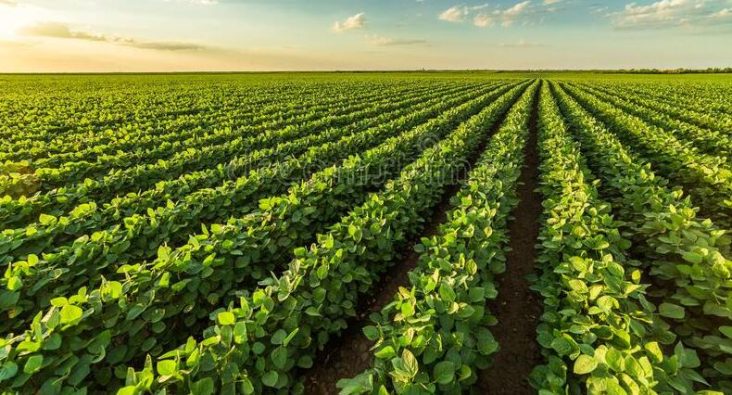Arkansas soybean farmers enjoy banner year in 2022
by January 9, 2023 3:44 pm 831 views

Arkansas largest crop, soybeans, had a banner year in 2022. Farmers harvested 3.15 million acres, up nearly 140,000 acres from 2021, according to the U.S. Department of Agriculture. Yield from those acres is projected to top 53 bushels per acre, a state record.
In 2021, the state’s soybean crop was valued at more than $1.94 billion, according to the 2022 Arkansas Agriculture Profile, and last year’s crop could approach $2 billion in value.
But there are issues that should be concerning to farmers says Jeremy Ross, extension soybean agronomist for the University of Arkansas System Division of Agriculture. Potassium deficiency in Arkansas’ most valuable row crop is becoming more prevalent in the state.
The deficiency is hardly noticeable from visual inspection. An accurate diagnosis requires tissue samples to be analyzed.
“We’re going to be encouraging soybean farmers more next year to send in tissue samples to test potassium levels in soybean plants and take advantage of the free tools available through the Division of Agriculture for potassium recommendations,” Ross said.
While nitrogen fertilizer is often the focal point of most row crop systems, potassium deficiency is the primary limitation affecting soybean profitability, according to Trenton Roberts, professor of crop, soil and environmental sciences for the Division of Agriculture. Soybeans obtain most of their nitrogen through a symbiotic relationship with soil microbes called biological nitrogen fixation.
Two tools developed through the Arkansas Agricultural Experiment Station, the research arm of the Division of Agriculture, include the profit-maximizing potash rate calculator and information on dynamic critical tissue potassium concentration thresholds. The potassium rate estimation tool is available on the Decision Support Software website. Roberts said the critical tissue potassium concentration thresholds are available upon request from a Cooperative Extension agent. He is working to have the information available online. Roberts said the tools help determine when, where, and how much fertilizer to apply.
While the high heat and drought put a strain on irrigation, the dry conditions suppressed disease pressure and led to a faster harvest, which allowed many farmers more time to prepare their fields for next year’s planting season. Pending the spring weather, that could help them plant soybean crops sooner next year, Ross said.
“A bright spot this year was that we got harvested quicker than in the past several years,” Ross said. “A big problem with the drought this summer was that the Mississippi River got too low to ship grain. A lot of the elevators got full, so storage was in high demand.”
Insect pressure from bollworms and corn earworms was evident in many areas of the state, and stink bugs were plentiful, Ross said. The red-banded stink bug reappeared in droves this year, he added, which called for more spraying.
Palmer amaranth “pigweed” and ryegrass are gaining resistance to common herbicides in soybean fields, he added. A mixture of four herbicides is now recommended to control the weeds, but five could be necessary within a few years to combat growing resistance, he said.
Root-knot nematodes also continued to be a serious problem in Arkansas soybean fields. According to data from the Crop Protection Network economic losses to soybean crops in Arkansas from root-knot nematode increased 180% from 2011 to 2021. The network’s data, compiled from farmer input, show that root-knot nematode created a 4% yield loss of soybean crops in the state last year –– over 6.6 million bushels valued at over $84.6 million. Soybean cyst nematode damaged about $10.5 million in Arkansas soybeans in 2021.
Fiona Goggin, professor of entomology at the experiment station, continues researching a method to deliver immune-boosting peptides in soybean plants to protect them from root-knot and soybean cyst nematodes. While there are a variety of nematode-resistant cultivars that Arkansas growers can choose from, none can control all strains of soybean cyst nematode and root-knot nematode simultaneously, Goggin said. The nematodes cause similar damage to the plant but are genetically different.
Other challenges in 2022 included input costs on fuel and chemicals. A variety of global economic factors contributed to the high demand and costs, including inflation, the war in Ukraine, and China’s “blue sky” initiative put in place before hosting the 2022 Winter Olympics in February. China, a key supplier of urea, sulfate and phosphate to the global market, curbed fertilizer exports late in 2021 before hosting the winter games.
“Fuel prices were elevated compared to the past few years, and fertilizer costs were almost double,” Ross said. “Herbicide, insecticide, and fungicide prices were also up along with the demand. Trying to get products was a struggle sometimes during the year because the co-ops couldn’t get them.”
A category 4 hurricane that hit Louisiana in late August 2021 led to the largest glyphosate facility in the nation to shut down until mid-October 2021, and there was damage to grain elevators on the Gulf Coast that impacted fertilizer availability in 2022, Ross said.
Farmers have been growing soybeans in the Natural State for about a century. The state ranks in the top 10 among soybeans producing states, according to the Arkansas Soybean Board.
